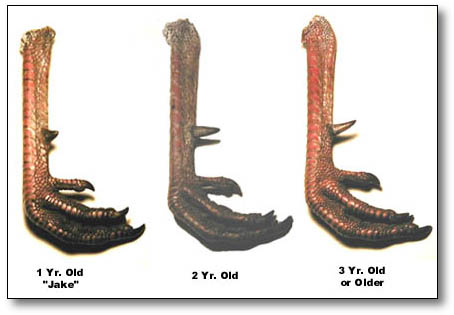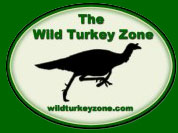Spur length is generally considered
to be the most reliable characteristic in determining
the age of a gobbler. Spurs will still show some
wear differences due to the habitat or geographical
area a turkey is found but generally they keep
getting longer and sharper as the turkey ages.
There are also differences in spur length between
the different sub-species.
Osceola's usually have the longest
spurs on average of the five American sub-species
due mostly to their environment. They generally
live in swamps and areas with soft dirt and few
rocks so they do not wear off the spur tips. Contrary
to this, the western subspecies, like the Merriam's,
often live in very rocky, or mountainous areas
which usually means even very old birds will have
spurs that have been worn off to less than 1 inch
long.
The photo below shows
the typical spur characteristics of some different
aged gobblers.
 Jakes
(1 yr olds) have spurs which are usually 1/2"
or less and are generally very rounded. During the
spring season, jakes will range from having no more
than a bump for a spur to a better defined 1/2"
long spur like the one shown in the photo.
Jakes
(1 yr olds) have spurs which are usually 1/2"
or less and are generally very rounded. During the
spring season, jakes will range from having no more
than a bump for a spur to a better defined 1/2"
long spur like the one shown in the photo.
The 2-yr old
gobbler has longer spurs (1/2" to 1")
which are generally still straight and still very
blunt on the ends.
3-yr. olds and older
birds have the longest, sharpest spurs and they
will also have some curve to them.
Again, spurs tend to
get longer and sharper as the gobbler ages but there
have been proven cases of some very old birds which
were tagged and harvested 7 to 8 years later that
still had spurs of only 1 inch in length.
There are a variety
of differing opinions on spur length in relation
to a gobbler's age so I'll present several theories
here along with some research stats.
One very interesting
study, "Indexes for Aging Eastern Turkeys"
by R. Kelly (1975) focused entirely on aging gobblers
in Missouri. This paper shows how spur length, beard
length and body weight are associated with known
age Eastern gobblers.
To begin the study,
a group of 50 known age gobblers were trapped as
sub-adults, and fourteen "minimum known-age"
gobblers were trapped as adults. The gobblers were
banded and released in various locations and then
were harvested in 20 different Missouri counties
from 1962 to 1974. Twenty-five sub-adult birds were
randomly selected from the 1973 harvest data in
two counties.
Data from the harvested
birds was collected and compiled, giving the following
table.
|
Age
of Birds
(Years)
|
# of Birds Sampled
|
Avg.
Spur Length
(in.)
|
Avg. Beard Length
(in.)
|
Avg.
Weight
(lb.)
|
|
1
|
25
|
.26
|
4.44
|
15.5
|
|
2
|
27
|
.87
|
9.47
|
21.1
|
|
3
|
11
|
1.01
|
9.46
|
21.9
|
|
4
|
7
|
1.08
|
9.00
|
22.5
|
|
5
|
2
|
1.16
|
10.93
|
23.8
|
|
7
|
2
|
1.38
|
10.83
|
23.3
|
|
9
|
1
|
1.38
|
10.43
|
20.0
|
|
"5"**
|
19
|
1.18
|
11.09
|
22.7
|
**
- This group of gobblers had a minimum known-age
of 5 years.
Length of Spurs and Beards and Body Weights
of Gobblers in Known Age Classes
Source - R. Kelly - "Indexes for Aging Eastern
Turkeys" (1975)
Third National Wild Turkey
Symposium, p. 207
|
Spur
Length
|
Curvature
|
Sharpness
|
Age
|
|
0" to 1/2"
|
Straight |
Rounded |
1 year or a jake
|
|
1/2" to 7/8"
|
Straight |
Blunt |
1 1/2 years (fall)
2 years (spring)
|
|
1' to 1 1/2"
|
Slight Curve |
Pointed |
2 to 3 years
|
|
Over 1 1/2"
|
Curved |
Sharp |
over 4 years
|
Estimating Gobbler Age by Spur Characteristics
Source - Williams - "After
the Hunt " (1996)
Note: These measurements are based on Florida
(Osceola) birds which generally have longer spurs
than Easterns, Rios etc.
|
Spur
Length
|
Age
|
|
0" to 1/2"
|
1 year or a jake
|
|
1/2" to 7/8"
|
2 years
|
|
7/8' to 1"
|
3 years
|
|
1" and above
|
4 plus years
|
Source - Keck - "Talk'n Turkey"
Turkey Call Magazine May/June 2001 p. 104

